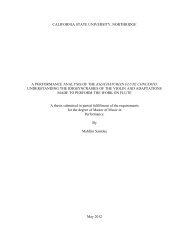2644 - CSUN ScholarWorks - California State University, Northridge
2644 - CSUN ScholarWorks - California State University, Northridge
2644 - CSUN ScholarWorks - California State University, Northridge
Create successful ePaper yourself
Turn your PDF publications into a flip-book with our unique Google optimized e-Paper software.
2731<br />
Journal of Student Research Abstracts · 43<br />
THE EFFECTS OF ENVIRONMENTAL POLLUTANTS ON PLANTS.<br />
Erica Lorraine Hooper and Steve DeGusta (teacher). John F. Kennedy High School, 6715 Gloria Drive,<br />
Sacramento, CA, 95831.<br />
This experiment was conducted to show the effects of environmental pollutants on plants and to answer the<br />
question, "Does chlorine, an environmental pollutant, disrupt the growth of plants?" Chlorine was used as the<br />
pollutant and onion bulbs were used as a sample of plants.<br />
Twenty small, white onion bulbs were placed on twenty test tubes. Ten tubes were filled with tap water, the<br />
control group, and ten tubes were filled with chlorinated water at three PPM. Each root of each bulb was measured<br />
and recorded daily for four days.<br />
I had assumed that the chlorine would have a negative effect on the plants because of it's effect on humans.<br />
Chlorine irritates human's sinuses and skin on contact. Chlorine tends to have a lower pH making it more<br />
acidic which dries out the skin and sinus cavities. I thought the plants would have a similar reaction. This led<br />
me to the hypothetical conclusion that if chlorine is harmful to the onion plants then the treated bulbs will have<br />
shorter roots and less roots than those grown in tap water.<br />
My hypothesis was not correct. According to my data the onion group grown in chlorinated water grew better<br />
than the control grown in tap water. Each day the roots of the experimental group grew longer and faster<br />
than the control group. Probability is less than 0.005. There were no other physical differences between the<br />
two groups. Neither group changed color or shape.<br />
The only explanation I have for this outcome is that the chlorine killed all of the bacteria making it easier<br />
for the plants to grow but the concentration was not strong enough to do any harm to the plant itself.<br />
2732<br />
EFFECTS OF SALT WATER ON THE GERMINATION AND INCIPIENT<br />
GROWTH OF MUSTARD SEEDS AND BLACK BEANS<br />
E. Kim. Teacher: W.P. Van Duzee. Saugus High School, 21900 Centurion Way, Saugus, CA 91350.<br />
The purpose of this experiment was to examine the effects of table salt, sodium chloride, on the germination<br />
and development of mustard seeds, B. Juncea, and black beans, genus Glycine. Two containers each holding<br />
soil and 100 mustard seeds were set in the same room in order to provide a constant temperature. Another<br />
set of two containers each holding soil and 100 black beans were set in the same room as the mustard seeds.<br />
Two containers containing the control plants-one container with mustard seeds and the other with black<br />
beans-were watered without table salt once a day for 10 days. The remaining two containers containing the<br />
experimental plants-one container with mustard seeds the other with black beans-were watered with a 10%<br />
solution of salt once a day for 10 days. On the lOth day, the control group containing mustard seeds and black<br />
beans were measured to have an average height of 1.09 inch and 1.38 inches, respectively. The experimental<br />
group containing mustard seeds and black beans both showed no signs of growth. These results show that the<br />
use of 10% salt water on mustard seeds and black beans prevents germination and growth.













